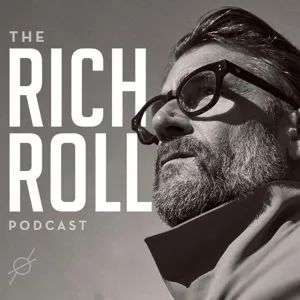Podcast Summary
Hidden costs of meat production: Meat's artificially low price hides externalities like animal suffering, environmental degradation, and health issues, which disrupt our food system balance
The price of meat being artificially low is causing significant externalities that harm animals, the environment, and even humans. Economist Ezra Klein argues that the true costs of meat production, such as animal suffering, environmental degradation, and health issues, are often hidden and paid by someone else. These externalities distort our decision-making and disrupt the balance in our system. To create a healthier relationship with the food we eat and the world we live in, it's essential to acknowledge and address the real costs of meat production. Mercy for Animals CEO and President Lee Garces, who has worked on various aspects of the meat industry, provides a comprehensive perspective on the issue. This conversation may not be easy to listen to, but it's an essential discussion for everyone to understand.
Industrial farming leads to cheaper chicken: Chickens are raised in overcrowded warehouses, denied natural behaviors, and treated as widgets, resulting in cheaper meat for consumers
The cheaper cost of meat, particularly chicken, over the past 50 years is largely due to economies of scale in the agricultural industry. Chickens today grow faster and bigger in overcrowded warehouses, with each bird given less space, leading to a sea of birds unable to move or exhibit natural behaviors. This industrial approach treats chickens more like widgets in a machine rather than sentient beings. One specific example of this is the use of battery cages for laying hens, where birds are kept in barren cages and denied their natural behaviors, leading to aggressive behaviors and the industry's solution of searing off their beaks. Despite the denial of their natural needs, this industrial approach allows for increased output and economies of scale, resulting in cheaper chicken meat for consumers.
Mass production of animals for consumption: Overwhelming numbers: The US consumes an average of 27 animals per person per year, with a projected need to double current numbers by 2050 due to unsustainable consumption patterns and increasing population.
The mass production of animals for human consumption, particularly in the form of chicken, results in overwhelming numbers of individuals being raised and slaughtered each year. The US is a significant contributor to this number, with an average consumption of around 27 animals per person per year. Last year saw the highest number of animals consumed in human history, and the FAO predicts that by 2050, we will need to double the current number if consumption patterns remain the same. This is unsustainable due to the increasing human population and the resource demands of meat production. Despite the efficiency gains, the individual animals continue to suffer greatly in this industrialized system.
Selective breeding and unnatural living conditions impact animal health and meat quality: Animals raised for consumption suffer due to selective breeding and unnatural living conditions, resulting in health issues, premature death, and lower quality meat for consumers
The animals we consume today, particularly chickens, have been drastically altered through selective breeding and unnatural living conditions to grow larger and faster than their natural abilities. This results in animals that suffer and often die young due to heart attacks and other health issues. These chickens are kept in cramped, unsanitary conditions, leading to bare, red chests and constant contact with feces. The meat from these chickens has also changed, with higher fat content and deterioration of the breast muscle leading to white striping. These practices not only cause suffering for the animals but also result in meat that is less healthy for consumers.
Industrial animal agriculture: 99% of US animal farming: Most farmed animals live in overcrowded, indoor conditions, denied natural behaviors. Seek certifications for animal welfare beyond labels like cage-free.
The vast majority of farmed animals in the United States and globally are raised in industrial animal agriculture, where they are kept entirely indoors in overcrowded conditions and denied the majority of their natural behaviors. This system, which is used for most chickens, as well as other animals like pigs, is responsible for 99% of animal agriculture in the US. Cage-free eggs, which have become more common due to consumer pressure, are still part of an industrial system and do not guarantee a life worth living for the animals. For those interested in improving animal welfare, it's important to look beyond labels like cage-free and seek out certifications that ensure animals have access to natural light, outdoor areas, and other basic needs.
Use of gestation and farrowing crates causes distress for pregnant and new mother pigs: Industrial pig production uses crates that restrict natural behaviors, causing emotional and physical distress for pigs, and the overuse of antibiotics contributes to animal suffering and human health risks.
The use of gestation crates in the industrial production of pigs results in inhumane living conditions for the animals, causing them immense emotional and physical distress. These crates, where pregnant pigs are kept unable to turn around, are the norm in the industry despite the animals' natural instincts to build nests and care for their young. After giving birth, the mother pigs are kept in farrowing crates, which allow their piglets to move in and out but still keep them confined. The removal of their piglets causes the mothers to suffer emotionally and physically, leading to behaviors like bashing their faces against the bars. The normalization of this treatment allows for mass production of piglets in small areas, but at the cost of the animals' wellbeing. Furthermore, the overuse of antibiotics in animal agriculture, with around 70% of medically important antibiotics being sold for animal use, contributes to both animal suffering and human risk through the development of antibiotic-resistant bacteria.
Antibiotic resistance in animal agriculture endangers human health: Continued overuse of antibiotics in animal agriculture risks entering a pre-antibiotic phase, causing 10 million deaths annually by 2050 if no changes are made, requiring improvements in animal living conditions and selective breeding for robust immune systems.
The overuse of antibiotics in animal agriculture is a significant concern for human health. If we continue to pump animals with antibiotics at current rates, we risk entering a pre-antibiotic phase where simple infections could result in death. This is because bacteria are learning to mutate around antibiotics, leading to antibiotic resistance. Every 15 minutes in the US, someone dies due to an infection that antibiotics can no longer effectively treat. By 2050, it's estimated that 10 million people a year could die of drug-resistant diseases if we don't make drastic changes. The industry's reluctance to change lies in the fact that it would require not only improving the conditions in which animals are raised but also selectively breeding animals with robust immune systems. This would be more expensive, but the long-term cost of a world in which many antibiotics have become useless could be much greater.
Animal agriculture's impact on global issues: Animal agriculture contributes to zoonotic diseases, climate change, and externalized costs, with livestock farming being a significant contributor to greenhouse gas emissions, and the industry's impact on climate change often overlooked in policy discussions
The agriculture industry, particularly animal agriculture, contributes significantly to various global issues, including the creation of zoonotic diseases and climate change. The industry's focus on poor conditions, genetics, and immune systems for animals results in externalized costs, such as antibiotic resistance and death. Moreover, the way animals are raised creates ideal conditions for the spread of zoonotic diseases, which can be transmitted to humans. Additionally, livestock farming, particularly cattle, is a significant contributor to greenhouse gas emissions, with estimates suggesting it may be responsible for up to 14.5% or even as high as 25-26% of global emissions. The industry's impact on climate change is largely absent from policy discussions, which hinders progress towards addressing this critical issue. The vast amount of land used for agriculture, most of which is for raising livestock, further contributes to these problems.
Animal agriculture's impact on land use and deforestation: Shifting to plant-based diets could reduce global land use for agriculture by 75%, saving resources and reducing environmental damage, but animal agriculture's externalized costs often fall on vulnerable communities and the environment
Animal agriculture is a major contributor to land use and deforestation, with around 80% of all agriculture land being used for animal farming and feed crop production. This inefficient system uses 100 times more land to produce a calorie or gram of protein from animals compared to plant-based alternatives. If everyone shifted to a plant-based diet, global land use for agriculture could be reduced by 75%. However, the industry has externalized many costs, including environmental damage, which are not reflected in the price of meat. These hidden costs are often borne by vulnerable communities and the environment. It's crucial to reconsider how we use our limited arable land and reduce the use of land for animal agriculture to ensure a sustainable food system for the future.
Hidden costs and harms in consumer goods and services: Many externalized costs in industries like agriculture and energy production, such as destruction of the Amazon rainforest and emissions from factory farms, are not reflected in prices and can lead to a distorted understanding of consumption choices. Advocate for transparency and accountability to promote sustainability and social justice.
Many costs and harms in our consumer goods and services are hidden and externalized, meaning they are not reflected in the prices we pay or the transactions we make. This is particularly true for industries with significant environmental and social impacts, such as agriculture and energy production. For example, the destruction of the Amazon rainforest to raise cattle for meat or the emissions from factory farms contributing to air pollution and health issues for nearby communities. These costs are often borne by third parties, such as future generations or low-income communities, and are not transparent to consumers. This lack of transparency and accountability can lead to a distorted understanding of the true costs of our consumption choices. It's important to be aware of these externalities and advocate for policies and practices that internalize these costs and promote sustainability and social justice.
Corporations setting up in powerless areas causing environmental harm: Corporations setting up in areas with less political and economic power lead to environmental externalities like air pollution and nutrient overflows, negatively impacting local communities. Accountability and regulation are crucial to mitigate these issues.
Large corporations, such as hog farming industries, often set up operations in areas where communities have less political and economic power, subjecting them to environmental externalities like air pollution and nutrient overflows leading to dead zones. For instance, hog farmers spray waste onto fields next to residential areas, affecting the health and quality of life of nearby residents. The lawsuit against Smithfield resulted in a nearly half-billion-dollar settlement, but individuals like Renee Miller, who suffers from severe respiratory infections, still live next to the farms. The legislature then passed a law preventing similar lawsuits from happening again. Additionally, the use of fertilizers on crops grown to feed factory-farmed animals results in nutrient overflows into waterways, creating dead zones, such as the one in the Gulf of Mexico, which is the size of Rhode Island and devoid of normal marine life. These issues underscore the importance of addressing the geographic and power dimensions of environmental issues and ensuring that corporations are held accountable for the negative impacts on communities.
Factory farming leaves small farmers in debt and exploitation: Factory farming puts small farmers in a cycle of debt, exploitation, and financial hardship due to externalized risks and liabilities by corporations
The factory farming industry, driven by the pressure to lower meat prices, has put small farmers in a debt-ridden, inhumane situation. These farmers are often left with no choice but to keep raising animals to pay off their debts, leading to a cycle of debt and exploitation. The externalization of risks and liabilities by corporations leaves farmers in a vulnerable position, with many facing financial hardships and even suicide. The nature of their work, such as raising chickens, is far from the idyllic image of farming, and many farmers are surprised and open to dialogue about their struggles. It's important to recognize the potential for alliance and support in transitioning these farmers to more sustainable and alternative farming methods, as many are innovative and collaborative in their efforts to break free from the current system. Additionally, taxpayers unknowingly subsidize this system, perpetuating its existence and the hardships faced by farmers.
Government subsidies in agriculture allow industry overproduction and externalize costs: Government subsidies enable agricultural industry, specifically poultry and livestock, to overproduce, leading to ethical concerns and challenges to animal welfare regulations like Prop 12 in California
The agricultural industry, particularly in the case of poultry and livestock production, receives significant financial support from the government through subsidies. This assistance keeps the industry afloat, but also allows it to overproduce and externalize costs onto the public. For instance, during times of overproduction, the government has purchased surplus livestock and paid for their mass slaughter, which raises ethical concerns. Prop 12 in California, which aimed to improve animal living conditions, is currently being challenged in the Supreme Court, with the industry arguing against the will of the majority of voters. This situation highlights the industry's ability to wield political and legal power to maintain its current practices, often at the expense of animal welfare and public opinion.
California's Prop 12 and the Ethical Dilemma of Animal Welfare Regulations: The Prop 12 debate in California raises ethical concerns about animal welfare and interstate commerce, with both sides appealing to core values in the political landscape.
The Prop 12 debate in California raises profound questions about state regulation and interstate commerce, while also highlighting the ethical concerns surrounding animal welfare. Despite a large majority of Californians supporting stricter animal treatment regulations, the Supreme Court and the Biden administration have sided with the pork industry, citing negligible change and burden. However, the oral arguments reveal that this issue transcends party lines and resonates with core values in both the progressive and conservative landscapes. The Supreme Court's consideration of the morality of the system adds an important layer to the discussion, and regardless of the outcome, it serves as a significant learning moment for our political landscape.
Encouraging compassion towards animals in children: Encourage children to consider the source of their food, expand their moral circle, and support ethical and sustainable food systems, without pushing veganism on them.
While it may be challenging to raise compassionate children in a world where animal suffering is often hidden, it is important to try. By encouraging children to consider the source of their food and the impact it has on animals, we can help them develop their compassion muscle and expand their moral circle. This doesn't mean everyone needs to become vegan, but rather striving for a more ethical and sustainable food system where animals are treated with respect and dignity. It's a long-term goal, but an achievable one that offers personal and collective growth. Additionally, recognizing the distinction between traditional farming practices and factory farming is crucial. The former can be defensible, while the latter is not. By taking small steps towards a more ethical and sustainable food system, we can make a difference.
Addressing environmental and ethical concerns in meat industry: Regulations, taxes, regenerative agriculture, and reading recommended books can help address environmental and ethical concerns in the meat industry, leading to increased prices and decreased consumption.
Addressing the environmental and ethical concerns related to the meat industry requires internalizing the costs through regulations and potentially taxes. This would lead to a increase in price and a decrease in consumption. A shift towards regenerative agriculture, which focuses on soil health and regeneration, could result in a drastic reduction in the number of animals raised and a significant increase in price. Three recommended books on the topic are "Waste Lands" by Corbin Addison, "Metonics" by David Robinson-Simon, and "Animal Machines" by Ruth Harrison. These resources provide valuable insights into the issues with factory farming and the potential solutions.



 Fabulous quotes
Fabulous quotes
